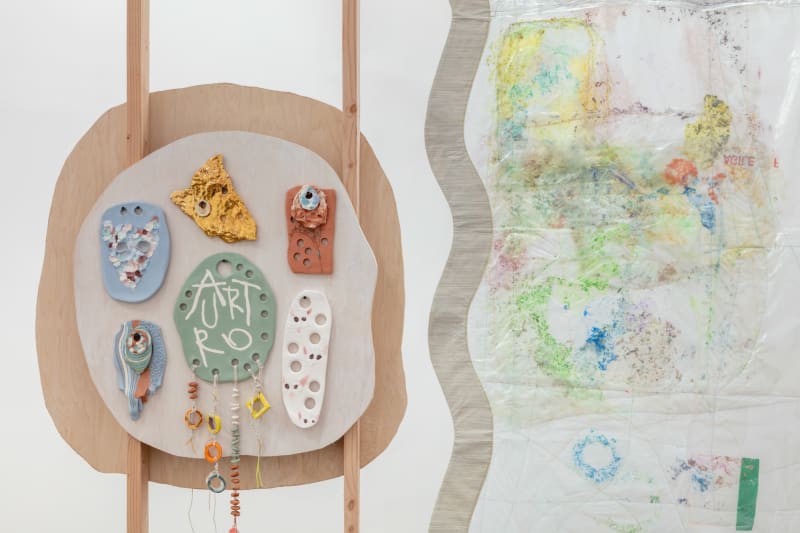Andrea Lerda in dialogue with Ludovica Gioscia:
AL
Your practice well expresses the potential of art to generate new visions.
In the exhibition “Arturo and the vertical sea”, in particular, you venture into a reflection of great urgency which is affecting many disciplinary fields. I refer to the debate on the need to redefine the relationship between the human species and the multispecies complexity with which we cohabit this Planet.
Dream, imagination, energetic aura seems to me three important tools to generate new connections with the alterity.
Recently, the Italian anthropologist Matteo Meschiari said that “animism is one of the possible ways to generate new narratives, to go beyond our simple circle of possessions and belonging and to exercise our imagination”. Animis as a possible strategy to progress from the anthropocentric to an ecocentric or multicentric vision.
“Arturo and the vertical sea” is the representation of a world within which you and Arturo are in dialogue. Images, works, forms and colors tells about a dimension of generative coexistence full of meanings to be deciphered.
Somehow you formalize an animistic world. Your works propose, in a kind of way, a new type of language, a new empathic connection with that Edward O. Wilson, in his book "Biofilia" (Harvard University Press, 1990) defined “the biologic maelstrom”, isn’t it?
LG
I must admit I wasn’t aware of Edward O. Wilson’s theories. Thank you for sharing with me extracts from his seminal book Biophilia. It has been fascinating to read about Wilson’s ideas around a total co-existence of life as if it were one organism, a melting pot in which organic matter is entwined and layered into a constantly evolving force. Or at least this is my interpretation of the paragraph in which he describes life in a forest as a ‘biological maelstrom’. It reminds me of James Lovelock’s Gaia theory, in which life on planet earth interacts with inorganic matter to form a self-regulating complex system which sustains the right conditions for existence on the planet. I am very fond of Lovelock’s early work.
I do see my installations as worlds which contain a plethora of actors, all in dialogue with one another. Apparently chaotic, all the works co-exist to generate a variety of narratives. Isolated these actors would feel lonely, possibly sad.
Wilson’s description of life in the forest feels close to home at the moment. For my current solo show Arturo and The Vertical Sea, I have collaborated with Arturo, my beloved feline companion. I do feel that at times we merge into one. I can only describe this state as semi-liquid, warm, profoundly reassuring, and purring. As a child my grandmother used to beat egg yolks with sugar and give it to me as a snack. It is a traditional Italian dessert called zabaglione. That is how we are together. We are zabaglione.
Our daily life together is tenderly woven into the new body of works. For example, there are a few small watercolours with splashes of vibrant colours. These are signals Arturo sends me when I gently hold his paw and we are about to drift off into deep sleep. That space just before falling asleep is a moment in which our minds connect in a particularly intense way. Many works contain Arturo’s joy, which I extrapolate from his combed hair and materials that he enjoys such as tissue paper. Our living room is covered with the latter. Arturo’s hair is also present in a few textile assemblages, one of which contains rolls of magnetic tape. My mother used to record the seances she performed in the eighties on cassettes. As a consequence of her rituals, magnetic tape to me has otherworldly properties – it connects the world we live in to the spirit world.
AL
The dialogue between you and Arturo necessarily implies a very close connection with your pet. Your project makes me think of the concept of empathy, and the need that the human species must rediscover to create a new dialogue with otherness, escaping from the comfort of reality and the anthropogenic dynamics that are familiar to it.
Chinese scholar Hung Ruyu speaks of “ecopedagogy” as a new form of education to develop “ecophilia”. Do you think that your artistic exercise could be an example of how to enter into a creative dialogue with other worlds and living beings?
LG
I am very interested in other worlds as places where alternative narratives exist and where events may be understood from different perspectives and contexts. These spaces are not outside of our sphere of cognitive perception, so I would not qualify them as fictional. ‘Other’ here does not imply a world that happens by virtue of fiction, but rather as an alternative to the one we are experiencing at this very moment. These worlds are spaces that I seamlessly inhabited as a child. They were gradually eroded by the western education system I grew up in, based on a model of linear time and disembodied abstract thinking. The consequence of this model is that I was brought up to understand life as an arrow travelling from left to right and encouraged to forget about my right brain hemisphere – the emotional brain. Yet that is where empathy is developed, and where important skills for interspecies communication reside. Certainly we must invest in forms of communication that do not rely solely on verbal language.
In my practice I reclaim and expand on those spaces that I once inhabited, and in doing so I hope to build bridges towards yet new ones.

